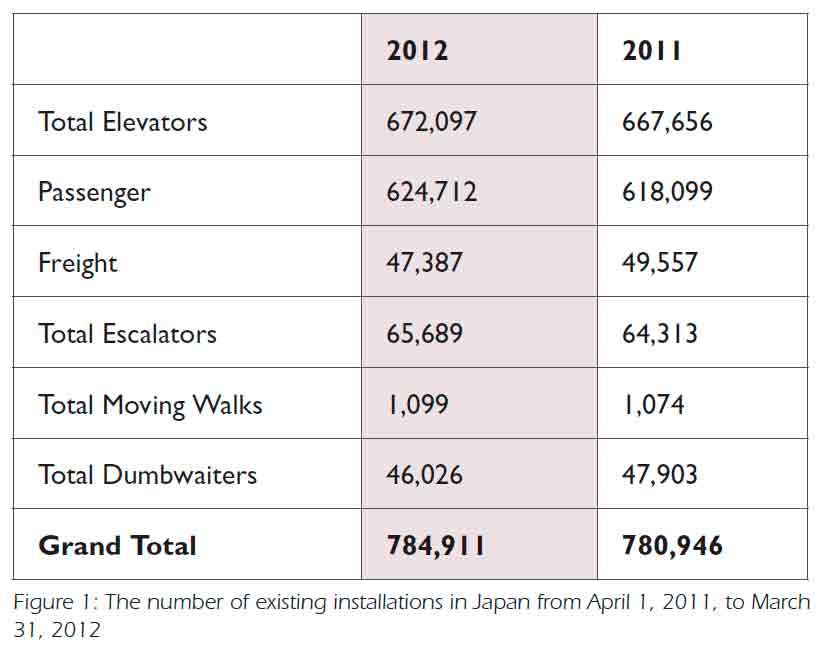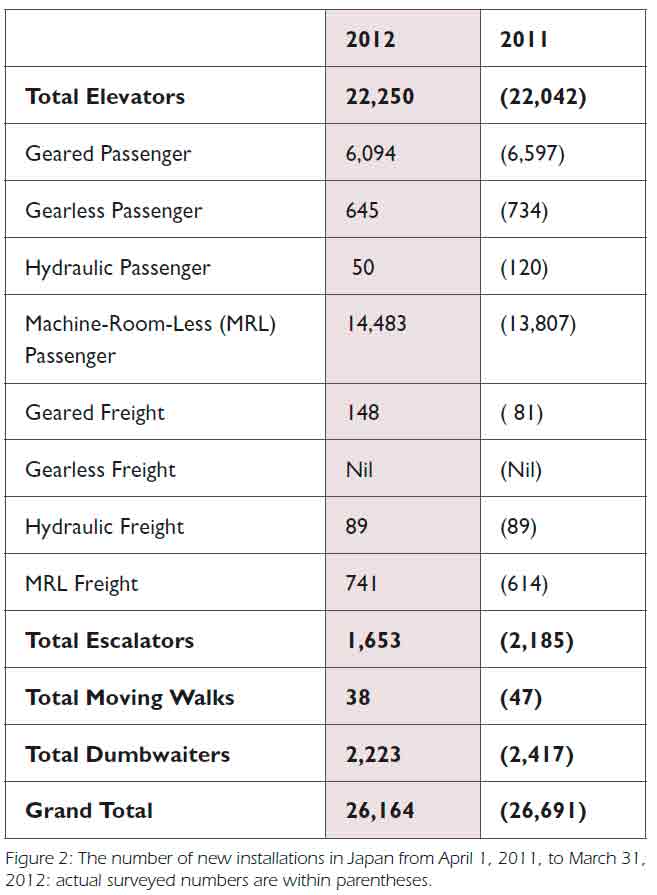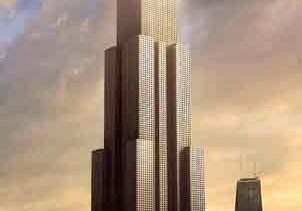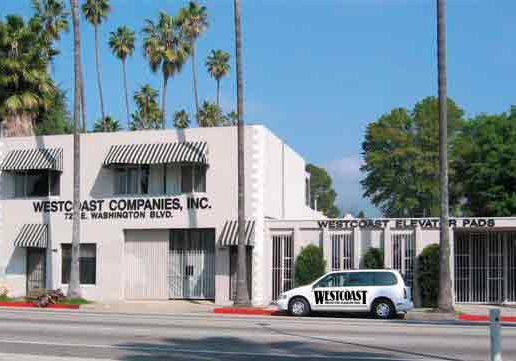Japan in the Aftermath: How the Industry Handled “The Great Quake”
Feb 1, 2013

Editor’s Note:
We committed to follow up on the report “Japan in the Aftermath: How the Industry Handled ‘The Great Quake’ – The State of Elevator and Escalator Restoration” (ELEVATOR WORLD, October 2011) after the next update was published by Elevator Kai, the Japan Elevator Association’s (JEA) quarterly magazine. Elevator Kai’s January 2012 issue featured an updated report as the cover story.
by The Japan Elevator Association
Once again, we express our sympathy to the families of those lost in the Great East Japan Earthquake and Tsunamis, which occurred at 2:46 p.m. (Japan Standard Time) on Friday, March 11, 2011, the epicenter of which was approximately 70 km east of Oshika Peninsula, Sanriku-oki, Miyagi Prefecture. Rating 9.0 in magnitude on the Richter scale, or Shindo 7 on the Japan Meteorological Agency’s seismic scale, the earthquake generated tsunamis that damaged a wide range of Pacific coastal areas. In addition to the main temblor, thousands of aftershocks followed, causing further damage to the area, stretching more than 1,100 km from the epicenter. Buildings and building equipment saw widespread damage. Fortunately, there were no reports of fatal accidents related to elevators or escalators. On a case-by-case basis, JEA surveyed elevator and escalator damage after the quakes, which showed severe damage to building equipment installed since 1987.
A Recent History of Earthquakes in Japan
The 1978 Miyagi earthquake occurred June 12, 1978, rating 7.7 on the Richter scale (Shindo 5) and caused 28 deaths and 1,325 injuries. The extent of building damage caused by the earthquake led to a revision of the Japanese Building Standard Act in 1981. Amendments to the Earthquake Resistant Standards of JEA followed; these became known as the 1981 Earthquake Resistant Standards (81 QRS). This earthquake led to a major overhaul of the Earthquake Insurance System created by the Japanese government in 1966.
The Great Hanshin earthquake, also known as the Kobe earthquake, occurred on January 17, 1995 in the southern region of Hyogo Prefecture. It initially measured 6.8 in magnitude and increased to 7.3 (Shindo 7). The focus of the quake was 16 km below its epicenter on the northern end of Awaji Island, 20 km from the city of Kobe.
The Niigata Chuetsu earthquake struck on October 23, 2004, with a 6.8 magnitude (Shindo 7). For the first time in its history, a Shinkansen (Japanese bullet train) derailed: eight of 10 train cars on the Joetsu Shinkansen line between Nogaoka and Urasawa stations derailed while in service.
The Chiba-oki earthquake struck on April 11, 2005, with a magnitude of 6.1 (Shindo 5).
Survey Overview
JEA asked its member companies to examine damage to their maintenance-contract elevators and escalators resulting from the earthquake, tsunamis and aftershocks from July 2011 to early September 2011. What follows is a brief report of the survey results.
Discussions were held with relevant JEA departments regarding how to conduct the damage investigation. It was determined that the study would focus on the March 2011 earthquake, tsunamis and Shindo 5 and greater aftershocks that occurred between March and June 2011. Twenty-two prefectures were surveyed, including Osaka, where super-tall buildings could have been affected by ground motion and Shino 3 aftershocks.
JEA member companies were asked to investigate damage to elevators and escalators under maintenance agreements. Dumbwaiters and certain restricted areas, such as regions within a 30-km radius of the irradiated Fukushima Daiichi nuclear power station, were excluded from the investigation. Survey sheets, which inquired about reports of fatal accidents, entrapments and extent of damage, were sent to member companies. Regarding elevator/escalator damage, we inquired as to which earthquake-resistant standards (prior to 81 QRS, 81 QRS, 98 QRS or 09 QRS) had been applied and if units were with or without seismometers (the presence or absence of an emergency control system). A preliminary list of damage was created based on a similar survey conducted in the aftermath of 1995’s Great Hanshin earthquake.
To aggregate and analyze results, a workgroup for damage analysis was formed consisting of 11 experts from JEA’s technical committee, maintenance committee and staff. This activity report is based on the workgroup’s efforts from September to November 2011.
Damage
In Osaka Prefecture where Shindo 3 was measured, there were 58 reports of damage to elevators and escalators, including 47 cases of damage to rails, steel tapes, ropes and cables. Elevator damage can be divided into three categories:
- Damage to fixed parts and/or deformation of main equipment by a horizontal seismic force, which shows falling, deformation and/or misalignment of traction machines, driving motors, motor-generator sets, speed governors, control panels and other fixed machine-room equipment
- Tangle and/or derailment of main ropes, cables and/or steel tapes by earthquake-shaken building structures, which indicates tangle, roll and/or swing of main ropes, governor ropes and/or traveling cables in the hoistway
- Secondary damage from collapsed and damaged buildings, meaning damage to the elevator system caused by crumbling entrance walls and/or hoistway walls: according to results from the survey, a primary cause of elevator damage was from counterweight blocks falling, which occurred in 49 cases. For escalator systems, shear and/or declination of building floors caused by the tremor damaged truss frames and/or platform cover plates, with 592 cases reported. The most serious damage to an escalator system resulted from the main body falling, as was evidenced in four reported cases.
Site Damage
Three serious types of damage to an elevator system exist. The first is falling and/or disposition of traction machines, driving motors, speed governors and/or machine-room control panels. The second is tangle and/or swing of main ropes, governor ropes, traveling cables and/or steel types in the hoistway. The third is falling counterweight blocks, which can cause fatal accidents. In each case, the highest occurrence rate is concentrated in Miyagi Prefecture where Shindo 7 was recorded. The situation should be monitored, since such accidents have occurred in prefectures measuring Shindo 5.
Summary
After reviewing the survey results, new measures should be implemented for Japan’s vertical-transportation industry:
- JEA should revise QRS instruction. In the past, when a serious earthquake causing heavy damage to buildings struck, JEA revised its standards as necessary. JEA has decided to implement firmer safety measures for the future.
- Further investigation is necessary to clearly evaluate the effects of QRS instruction issued in 2009, because few units have been installed since 2009.
- To further reinforce elevator and escalator systems against earthquakes, JEA feels the need to strengthen a sufficient cooperative structure between building designers and architects. We have learned that some damages were relevant to the joined portions of building structure and secondary disasters caused by collapsed buildings.
- Further focus is needed for avoiding falling of counterweight pulleys/blocks and/or an escalator body. This issue should be approached as a pressing problem to be solved. We urge our member companies to reaffirm the significance of 2009 QRS and to adopt measures for avoiding these falling accidents.
- To avoid falling accidents of an escalator body, the Ministry of Land, Infrastructure, Transport and Tourism has urged JEA to establish a committee to discuss additional preventive efforts in the context of current JEA QRS.
- Additional topics to be examined by the newly established committee:
- The possibility of a major earthquake and its intensity scale
- Re-evaluation of seismic design standards
- Re-examination of escalator design and installation standards relating to the previous two points
Acknowledgement
We have compiled the survey results and analyses with sufficient cooperative assistance from JEA member companies. JEA plans to increase efforts toward the realization of safer and more secure elevator and escalator systems through continuation of data analysis and discussion of safety measures. JEA would like to express its appreciation to the member companies for their data collection, analyses and provision of such valuable information.
Get more of Elevator World. Sign up for our free e-newsletter.









